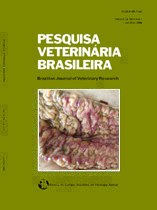 |
|
|
|
Year 2013 - Volume 33, Number 12
|

|
Anthelmintic resistance in gastrointestinal nematodes of small ruminants: advances and limitations for diagnosis, 33(12):1391-1402
|
ABSTRACT.- Fortes F.S. & Molento M.B. 2013. [Anthelmintic resistance in gastrointestinal nematodes of small ruminants: advances and limitations for diagnosis.] Resistência anti-helmíntica em nematoides gastrintestinais de pequenos ruminantes: avanços e limitações para seu diagnóstico. Pesquisa Veterinária Brasileira 33(12):1391-1402. Laboratório de Doenças Parasitárias, Universidade Federal do Paraná, Rua dos Funcionários 1540, Curitiba, PR 80035-050, Brazil. E-mail: fortesfs@gmail.com
The selection and growing spread of resistant nematodes to the most commonly used anthelmintics, benzimidazoles (BZs), imidazoles and macrocyclic lactones (MLs), constitutes a serious obstacle of small ruminants production worldwide. The use of efficient and sensitive methods for detection and monitoring of anthelmintic resistance in the field becomes urgent, especially for the BZs and MLs groups due to its frequent resistant reports. Obtaining an early and accurate diagnosis of resistance is extremely important to aid decision-making regarding parasite control programs, with the objective to preserve the lifespan of existing products, and to limit the development of resistance in nematode populations. The in vivo tests and the more recent in vitro tests have been developed for the detection of nematode resistant to the major anthelmintic groups. However, the availability of validated in vitro tests and its practical use is still very limited. Although the faecal egg-count reduction test (FECRT, in vivo - indirect) is the primary method of choice for the detection of resistance in the field it has being criticized for its results and is receiving significant modifications. Moreover, the development of molecular techniques from genomic changes have generated considerable advances in this research area, with the use of mutations at codons 167, 198 and 200 of β-tubulin gene as the main SNPs (single nucleotide polymorphisms) associated with BZs resistance. This review aims to discuss the available diagnostic methods for the detection of anthelmintic resistance in nematodes of small ruminants, highlighting key developments and obstacles to its use in the laboratory and in the field. |
| |
|
|
| |
|
 |